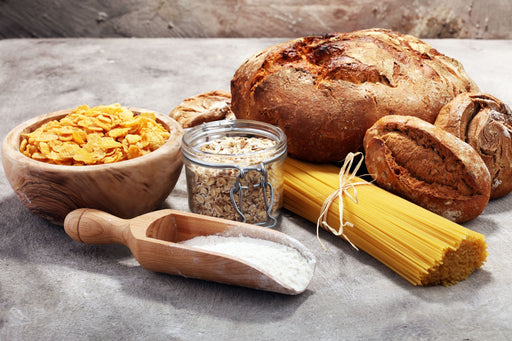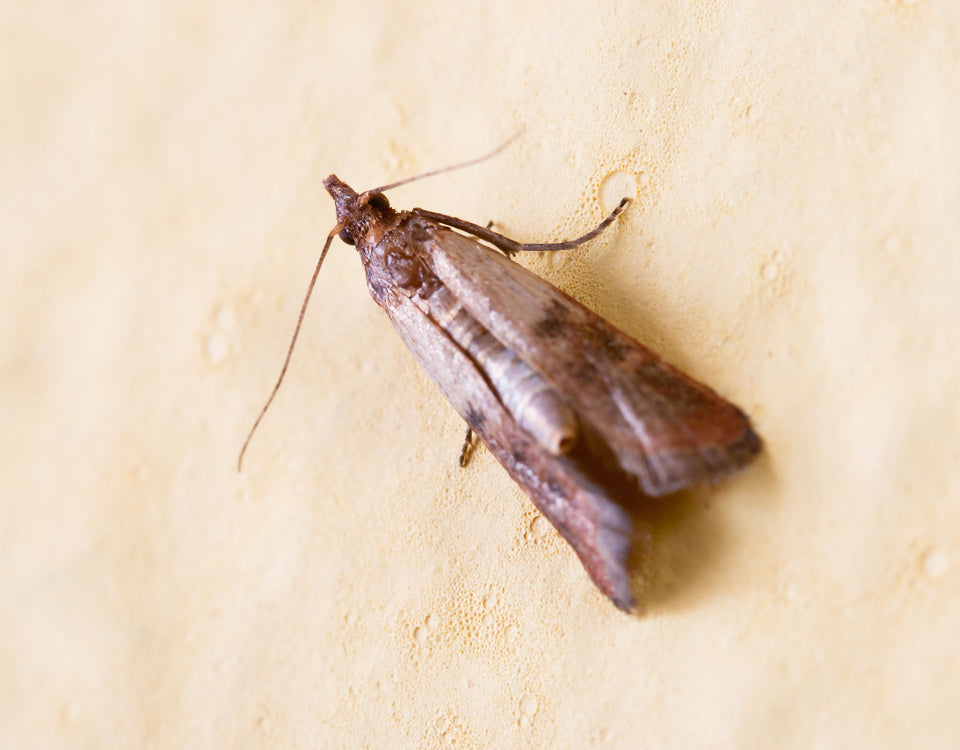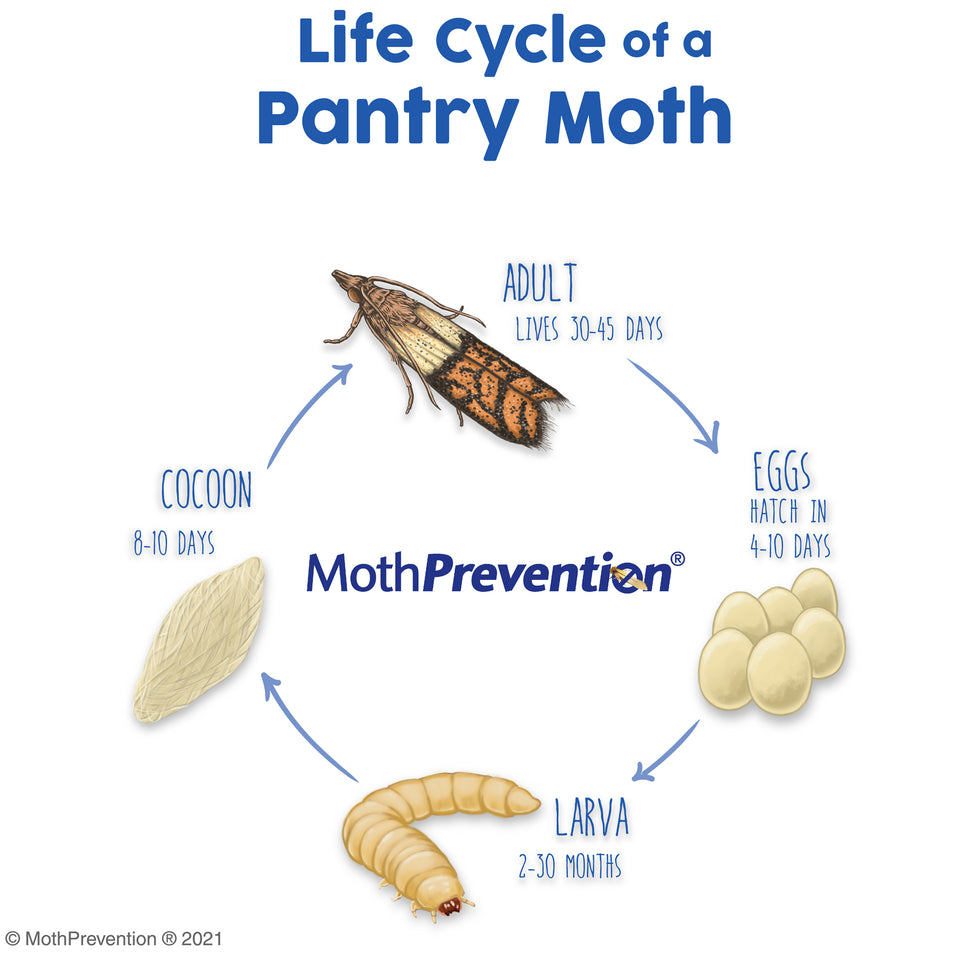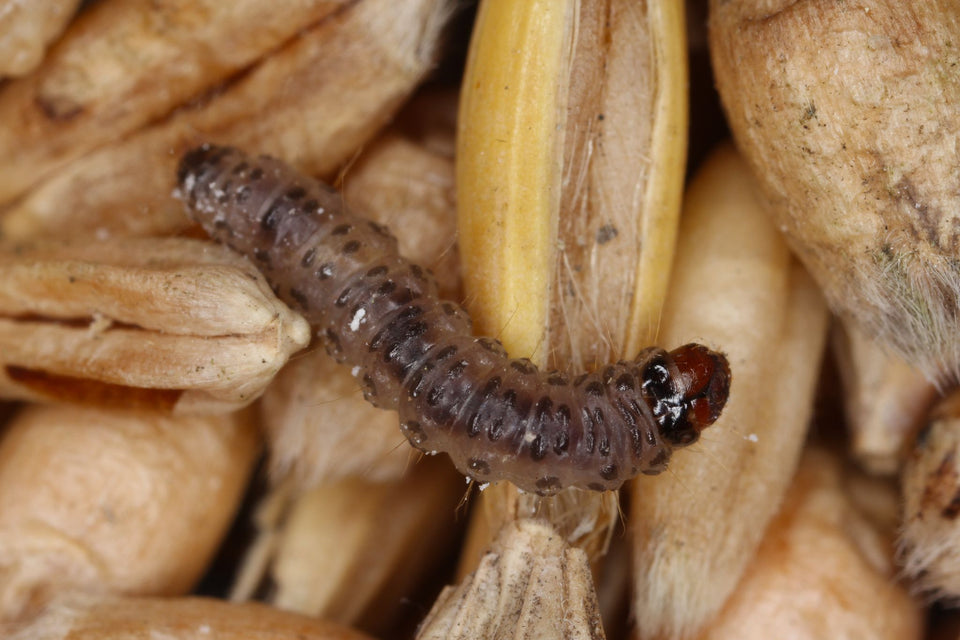The Food Moth Life Cycle

The Life Cycle of a Food Moth
Moths. Bet you never expected to see them inside your bag of flour, crawling around. How gross! Unfortunately, moths are attracted to more than just clothing and carpet. Turns out that some types absolutely love grains and nuts and will happily lay their eggs throughout your cupboards so the whole creepy-crawly family can enjoy the cereal, dog food, or other goodies you have.
If you are looking to control the pests in your kitchen, you need to know their life cycle, so you can nip their invasion in the bud. We have outlined the food moth life cycle for you below.
What Are Food Moths?
Also known as Indian meal moths, Food Moths are one of the more common kitchen pests. They can be found throughout North America and Europe, as well as other places. Because they love to feed on cereals, grains, and nuts, pantry moths often invade the household through such products. For example, some items from the grocery store could unknowingly contain eggs that will eventually mature and hatch larvae.
The food moth larvae then eat whatever food is surrounding them. When moths grow into adult moths, the females will lay up to 500 eggs during their lifespan. Because of this, Food Moth infestation can be a nightmare. Not only that, but those eggs and larvae can contaminate large portions of food.
Anything that comes into contact with pantry moths will need to be discarded. The good news? They’re not poisonous.
How to Identify a Food Moth

Food Moths in their adult form are easy to spot. They have bronze wings that may have a pattern, such as a horizontal black line through the middle. Others will look slightly lighter in colour.
The eggs are nearly invisible, but the larvae? Those are difficult to miss. Although several of them could fit on a small coin, they look a little like maggots (ew) and have off-white bodies. You will find them on corners, chewing through cardboard and covering their trails with white silk.
Food Moth Life Cycle

1. Food Moth Propagation
As mentioned earlier, a lone female Pantry Moth can lay nearly 500 eggs, with 300 eggs being the average. The moth will lay these eggs all at once or over 18 days.
The extremely tiny eggs will be near foodstuffs, especially strong-smelling or poorly packaged goods. Those eggs will then hatch within 7 days of being laid. Sometimes, it can take up to 14 days.
2. Food Moth Larval Stage
When Indian meal moths are in their larval stage, they will do the most damage. They’re voracious and will eat and eat, excreting something called frass (waste) as they do so. The frass and webbing will contaminate the food, and it will be unusable.
Depending on the conditions and availability of food, the larval stage will usually last for 2-3 months. However, in some places, the larvae will not mature for half a year (up to 210 days).

3. Food Moth Pupal Stage
Once the larvae have eaten themselves into a food coma, they move onto the pupal stage. During this time, the larvae make cocoons around their bodies in the crevices, corners, or cracks near their food source. Sometimes, the cocoons are hidden within clumps of webs and frass - a sure-fire sign that you have a Food Moth infestation.
About 15-20 days are spent as pupae transforming into adult Pantry Moths.
4. Adult Food Moth Stage
The final part of the Food Moth life cycle begins when fully grown moths erupt from their cocoons and start flying towards any light source you have in the kitchen. This common bump and grind against light bulbs is, comically, a way to attract a mate for reproduction. Interestingly, adult Food Moths do not have mouths, so they do not need food.
Their sole purpose is finding a light, finding a mate, and laying eggs to die. Because the lifespan of an adult moth is only 5-25 days, you often won’t see them until they are found while sweeping up dust bunnies.
So, to summarise: the full life cycle of a Food Moth is anywhere from 27 days to just over a year. Up to 8 generations of Food Moths can be born and die in a single calendar year, though cold weather will greatly hinder this process. That is why moths are rarely seen when the temperature drops below 50 degrees F/10 degrees C.
Dealing With Food Moths
No one wants to deal with something as disgusting and destructive as Kitchen Pantry Moths in their home. And when larvae can live for 60-90 days on average, you need to be able to tackle the problem head-on before they get a grip in your kitchen and foodstuffs.
There are a few things you can do to prevent Indian meal moths from making frass of your kitchen cupboards:
-
Never leave your food opened or in containers that do not seal properly. If there are any larvae in the food, they will eat their way out (or into) the plastic of other food, mature, and breed even more moths.
- Use resealable containers, silicone baggies, or even Mason jars for storage items like flour, nuts, oatmeal, and baking mixes.
Consider using food moth pheromone traps. The traps attract male Food Moths to a glue board, where they get stuck and die. Since the females cannot have their eggs fertilised, they will die without breeding.
-
Consider purchasing pantry moth traps to rid your home of these pesky nuisances.
Why Learn About the Food Moth Life Cycle
Adult Food Moths may not be harmful themselves, but they are not welcome guests in your home. Not with the mess they are sure to invite in. Food Moth larvae can quickly contaminate your kitchen, and that can be expensive to repair and replace everything affected. Knowing the Food Moth life cycle is just one way to be proactive about preventing a food moth infestation in your home because you will be able to monitor the situation and act accordingly.
About MothPrevention
MothPrevention® speak to customers every day about their clothes moth issues - clothes moths are a species that are ever increasing and that can cause significant damage to clothes, carpets and other home textiles.
To date, we’ve helped over 250,000 customers deal with their moth problems. We have developed professional grade solutions including proprietary pheromones and trap design engineered to the highest production standards.





